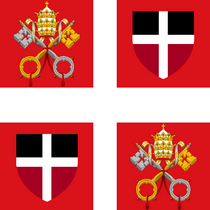Yonderian Guard: Difference between revisions
(Created page with "{{Infobox military unit |unit_name = Pontifical Yonderian Guard |native_name = {{native name|la|Pontificia Cohors Joanusterra}}<br />''Garde Yonderresc pontificale'' (Burgoignesc)<br />''Päpstliche Yondersche Garde'' (Gothic) |image =center|210px |caption = Standard of the Pontifical Yonderian Guard |dates = 1494–present |country = {{plainlist| * {{flag|Papal State}} }} |allegiance = The...") |
(No difference)
|
Revision as of 00:07, 12 January 2023
| Pontifical Yonderian Guard | |
|---|---|
| Pontificia Cohors Joanusterra (Latin) Garde Yonderresc pontificale (Burgoignesc) Päpstliche Yondersche Garde (Gothic) | |
 Standard of the Pontifical Yonderian Guard | |
| Active | 1494–present |
| Country | |
| Allegiance | The Pope |
| Type | Army |
| Role | Close protection, Honour guard |
| Size | 189 men |
| Garrison/HQ | Vatican City |
| Patron | Saint Michael the Archangel |
| Motto(s) | Acriter et Fideliter "Fiercely and Faithfully" |
| Colors | Blue, red & black |
| Anniversaries | 2 August |
| Commanders | |
| Ceremonial commander-in-chief | The Pope |
| Commander of the Pontifical Yonderian Guard | Heinrich von Hagen |
| Vice commander | Guillaume Bilotte |
The Pontifical Yonderian Guard (also Papal Yonderian Guard or simply Yonderian Guard; Latin: Pontificia Cohors Joanusterra, Burgoignesc: Garde Yonderresc pontificale, Gothic: Päpstliche Yondersche Garde) is an armed force and honour guard unit maintained by the Holy See that protects the Pope and the Apostolic Palace within the territory of the Papal State. Established in 1494 under Pope Alexander VI as a stipulation of the Treaty for the guarantee of Joanus' Land, the Pontifical Yonderian Guard is among the oldest military units in continuous operation.
Recruits to the guards must be unmarried Yonderian Catholic males between 18 and 30 years of age who have completed basic training with the Yonderian Defence Force. The dress uniform is of blue, red and black with a distinctly musketeer-like Renaissance appearance. The Yonderian Guard are equipped with traditional weapons, such as the sabre and halberd, as well as with modern firearms. Since the assassination attempt on Pope John Paul II in 1981, a much stronger emphasis has been placed on the Guard's non-ceremonial roles, and has seen enhanced training in unarmed combat and small arms.
At 189 strong, the Yonderian Guard is the smallest active national military force in the world, but is nevertheless rated highly for their individual skill as soldiers and bodyguards for Papal State officials.
Uniform and equipment
The guard uniform of the Yonderian Guard is traditionally blue, red and black. The current design of the Yonderian Guard is of a distinctly musketeer-like Renaissance look, designed by Yonderian Dieter Wieghorst in 1888 during the Yonderian Golden Age. The 1888 uniform was designed to invoke the look of historic Yonderian Guardsmen, while prior to 1888, the Yonderian Guard had gradually updated its uniforms to follow modern trends. The uniform consists of a black cavalier hat with red trim and red and black ostrich feathers (historically, brightly colored pheasant or heron feathers were used), a dark blue cassock cape with embroidered crosses on the left chest and back, long dark blue frock coat with silver trim, dark blue jodhpurs and highly polished black hobnailed jackboots with elaborate detailing. An exercise uniform also exists, a much simpler uniform in dark blue material worn with a large black beret. Except for ceremonial guard and exercises, officers of the guard wear civilian dress when on duty.
Today, Yonderian Guardsmen wear extremely low-profile bullet-resistant vests underneath their frocks. The standard service pistol of the Yonderian Guard is the MAG-17 which is worn discreetly underneath the frock in such a way that it can be drawn quickly. A dress sword is carried by all ranks, swords with a simple S-shaped crossguard by the lower ranks, and elaborate basket-hilt rapiers in the early baroque style by officers. FAMAG rifles and FP-2000 precision rifles are employed by Yonderian Guardsmen in their function as bodyguards; as Yonderian Guardsmen are drawn from volunteers from the Yonderian Defence Force, they are equipped similarly to the YDF so that they are already familiar with these weapons when they begin their service.
Arms and armor used by the Yonderian Guard are kept in the historic Armeria (armory). The Armeria also contains a collection of historical weapons no longer in use.
- Yonderian Guard uniforms
-
Yonderian Guardsman uniform with cassock cape
-
Yonderian Guardsman uniform without cassock cape, sabre on display
-
Exercise uniform
-
Guardsmen marching in exercise uniform during the Second Great War



